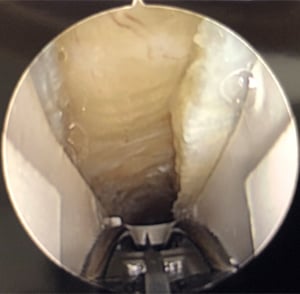Carpal Tunnel Surgery: How It Works and Recovery Time

Carpal tunnel syndrome is caused by compression of the median nerve at the wrist. It can result in pain, numbness, tingling, and weakness in the hand and fingers. In many cases, the condition can improve with nonsurgical treatments, but sometimes surgery is needed to relieve the pressure on the nerve.
When is carpal tunnel syndrome bad enough for surgery?
Carpal tunnel syndrome can often be treated initially with conservative options like activity modification, anti-inflammatory medications, therapy, splinting, and corticosteroid injections. When these treatments are no longer enough to relieve the symptoms of carpal tunnel syndrome, surgery can be considered. For patients with more severe symptoms or advanced findings like muscle loss (atrophy) or constant numbness in the fingers, surgery may also be recommended to improve symptoms and prevent the condition from getting worse.
What is carpal tunnel surgery?
Carpal tunnel release surgery consists of releasing a ligament in the wrist to relieve the pressure on the median nerve.
How does carpal tunnel surgery work?
Carpal tunnel release surgery is performed in the outpatient setting with local anesthesia or light sedation. It involves releasing the pressure on the median nerve by cutting the transverse carpal ligament. The procedure may be performed as an open or endoscopic surgery.
Open carpal tunnel release
In open carpal tunnel release, a hand surgeon makes a 2 to 3 cm incision in the palm directly over the carpal tunnel and cuts the transverse carpal ligament from the outside in.
Endoscopic tunnel release
In endoscopic carpal tunnel release, a hand surgeon makes a small (less than 1 cm) incision in the wrist area and uses a camera and specialized instruments to release the transverse carpal ligament from the inside out. The image below depicts the view from the camera after the transverse carpal ligament has been cut in endoscopic carpal tunnel release.

What are the advantages and disadvantages of open vs. endoscopic carpal tunnel release surgery?
Both types of surgeries are very effective at improving symptoms of carpal tunnel syndrome.
The advantages of endoscopic surgery include less pain, faster recovery, and earlier return to work and sports. Given the smaller incision, patients who have endoscopic carpal tunnel release can have less scar sensitivity and lower risk of wound complications after surgery.
Endoscopic carpal tunnel release requires more specialized instruments and experience with the procedure is important to minimize risk of complications. In some cases, endoscopic release may not be possible because of difficulties with visualization and individual anatomic variations. Studies have shown improved outcomes, fewer complications, and lower rate of conversion to open surgery when endoscopic surgery is performed by more experienced, higher volume surgeons.
How long does carpal tunnel surgery take?
Carpal tunnel surgery usually takes about 10 to 20 minutes.
Can you have carpal tunnel surgery in both hands?
Yes, it is possible to have carpal tunnel release surgery in both hands at the same time. However, in most cases, patients prefer to address the problem in one hand at a time.
What is the recovery time for carpal tunnel surgery?
Most patients can resume doing their daily activities within a few days after surgery. Return to more strenuous activities like sports or gym may require four to six weeks.
What to expect after carpal tunnel surgery
After surgery, patients go home the same day. The wrist is wrapped in a post operative bandage, leaving the fingers free. Follow-up in the office is after 1 to 2 weeks. With endoscopic surgery, patients may not have any stitches to remove. Many patients notice an immediate improvement in some of their symptoms, such as night time pain, numbness, and tingling. Patients with more severe, long-standing symptoms may take longer to notice improvement.
How long after carpal tunnel surgery can I drive?
Return to driving after carpal tunnel surgery can depend on many factors, including whether the patient had open or endoscopic carpal tunnel release, whether one or both sides are affected, and level of pain following the surgery. The range can be anywhere from a few days to about two weeks.
How much time off from work should I take to recover from carpal tunnel surgery?
Time off from work varies based on the patient and type of occupation. Most patients can return to desk work or light activities within 1 to 2 days. Patients who have more physically demanding jobs may need a few weeks to return to full duty.
Can carpal tunnel syndrome come back after surgery?
For most patients, the relief from carpal tunnel release surgery is long lasting, and they do not require another operation.
References
- Beck JD, Deegan JH, Rhoades D, Klena JC. Results of endoscopic carpal tunnel release relative to surgeon experience with the Agee technique. J Hand Surg Am. 2011 Jan;36(1):61-4. doi: 10.1016/j.jhsa.2010.10.017. PMID: 21193127. https://pubmed.ncbi.nlm.nih.gov/21193127/
- Hacquebord JH, Chen JS, Rettig ME. Endoscopic Carpal Tunnel Release: Techniques, Controversies, and Comparison to Open Techniques. J Am Acad Orthop Surg. 2022 Apr 1;30(7):292-301. doi: 10.5435/JAAOS-D-21-00949. PMID: 35255490. https://pubmed.ncbi.nlm.nih.gov/35255490/
- Miles MR, Shetty PN, Bhayana K, Yousaf IS, Sanghavi KK, Giladi AM. Early Outcomes of Endoscopic Versus Open Carpal Tunnel Release. J Hand Surg Am. 2021 Oct;46(10):868-876. doi: 10.1016/j.jhsa.2021.04.030. Epub 2021 May 25. PMID: 34049728. https://pubmed.ncbi.nlm.nih.gov/34049728/
- Trehan SK, Lyman S, Ge Y, Do HT, Daluiski A. Incidence of Nerve Repair Following Endoscopic Carpal Tunnel Release Is Higher Compared to Open Release in New York State. HSS J. 2019;15(2):143-146. doi:10.1007/s11420-018-9637-1. https://pubmed.ncbi.nlm.nih.gov/31327945/
- Wagner ER, Chung KC. Commentary on "Our Surgical Experience: Open Versus Endoscopic Carpal Tunnel Surgery". J Hand Surg Am. 2018 Sep;43(9):862-863. doi: 10.1016/j.jhsa.2018.03.030. PMID: 30172278. https://pubmed.ncbi.nlm.nih.gov/30172278/
- Wessel LE, Gu A, Asadourian PA, Stepan JG, Fufa DT, Osei DA. The Epidemiology of Carpal Tunnel Revision Over a 1-Year Follow-Up Period. J Hand Surg Am. 2021;46(9):758-764. doi:10.1016/j.jhsa.2021.04.003. https://pubmed.ncbi.nlm.nih.gov/34059387/
- Wessel LE, Gu A, Asadourian P, Stepan JG, Fufa DT, Osei DA. Incidence of Trigger Finger in Surgically and Nonsurgically Managed Carpal Tunnel Syndrome. J Hand Surg Glob Online. 2022;5(2):164-168. Published 2022 Nov 24. doi:10.1016/j.jhsg.2022.10.017. https://pubmed.ncbi.nlm.nih.gov/36974300/

